A new construction method of digital signature algorithms
Currently, the digital signature has been widely applied to
the fields of e-Government, e-Commerce, . in the world
and has been initially deployed applications in Vietnam to
meet the authentication requirements for the origin and the
integrity of information in electronic transactions.
However, the initiative research - development of new
digital signature schemes to meet the requirements for
product, safety equipment design - manufacture and
information security in the country has always been
essential problem arising. In the country, a number of
research results in this field have been published [1], [2],
[3], [4] and implemented in practical applications.
In this article, the authors propose a new construction
method of signature schemes based on difficulty of the
discrete logarithm problem in the field of finite elements.
As well as methods that have been proposed in [1], [2], [3],
[4], an advantages of the newly proposed method here is
that it can be used for the purpose of developing different
digital signature schemes to choose suitably to the
requirements of applications in practice
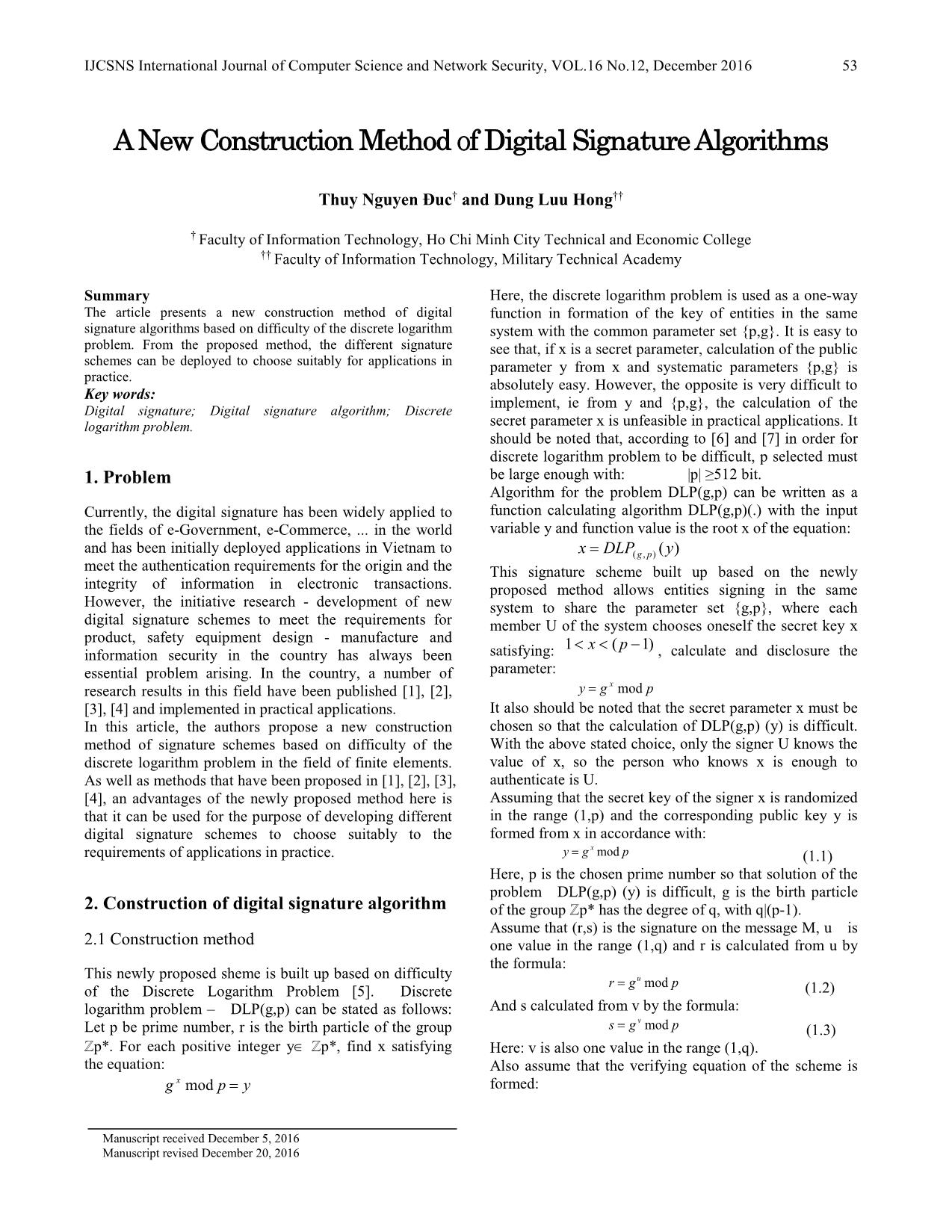
Trang 1
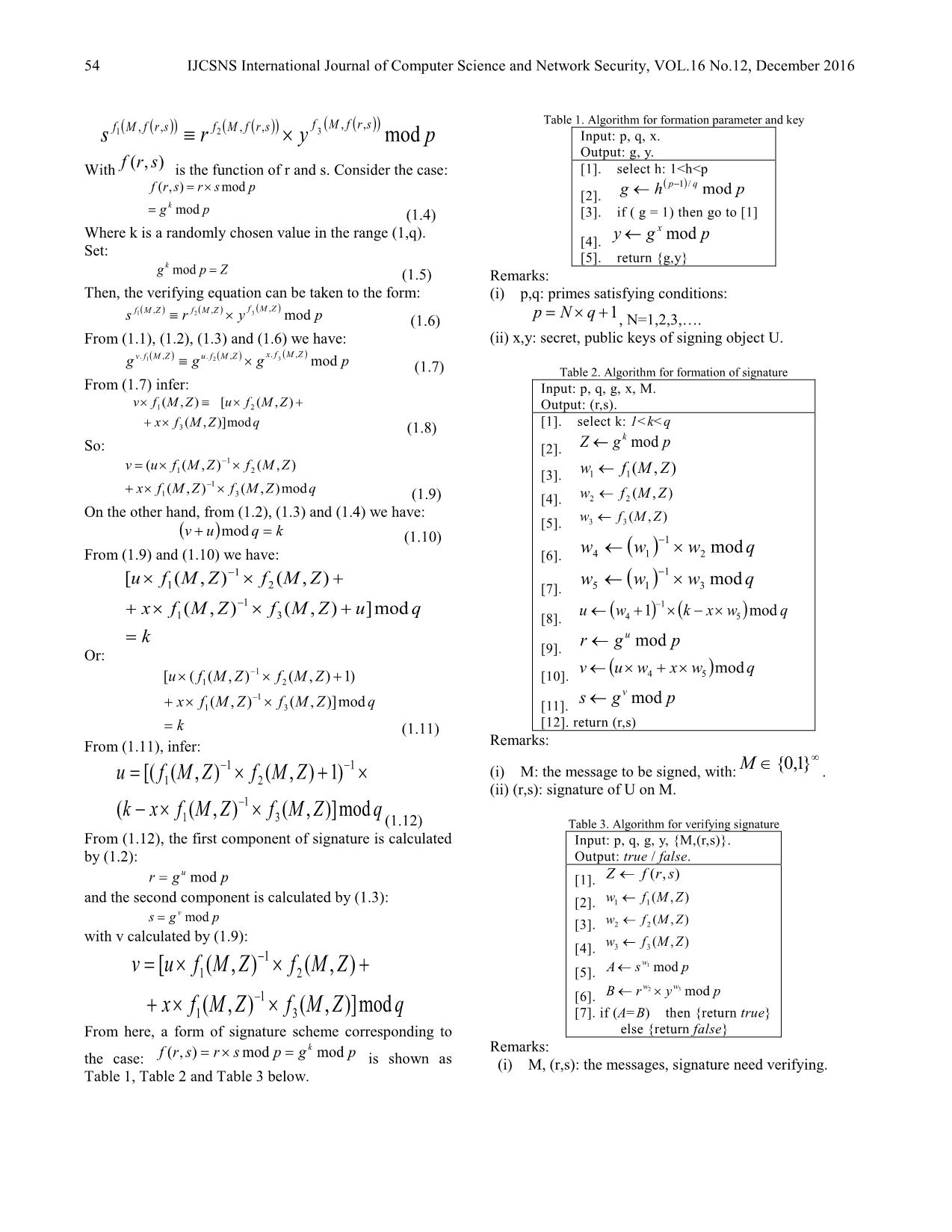
Trang 2
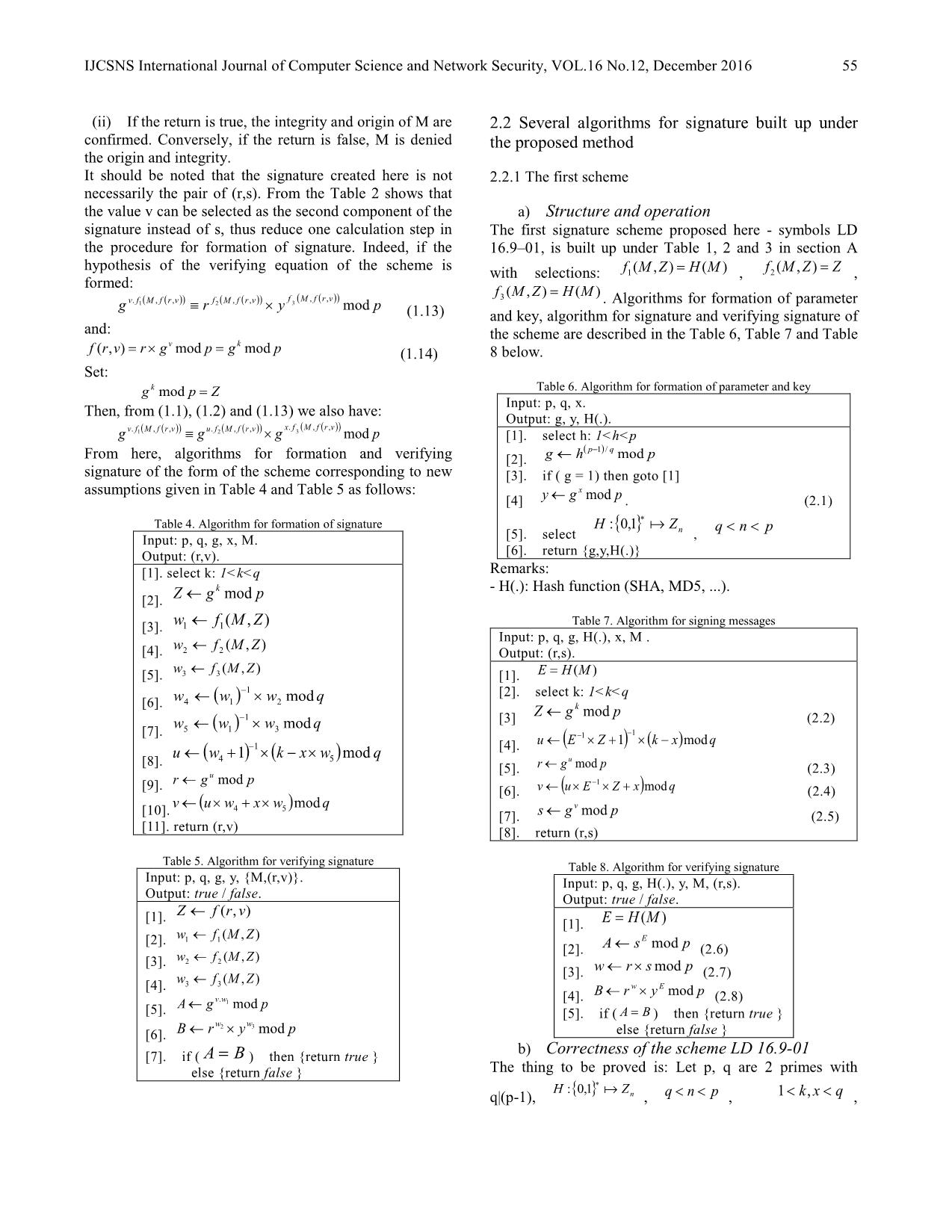
Trang 3
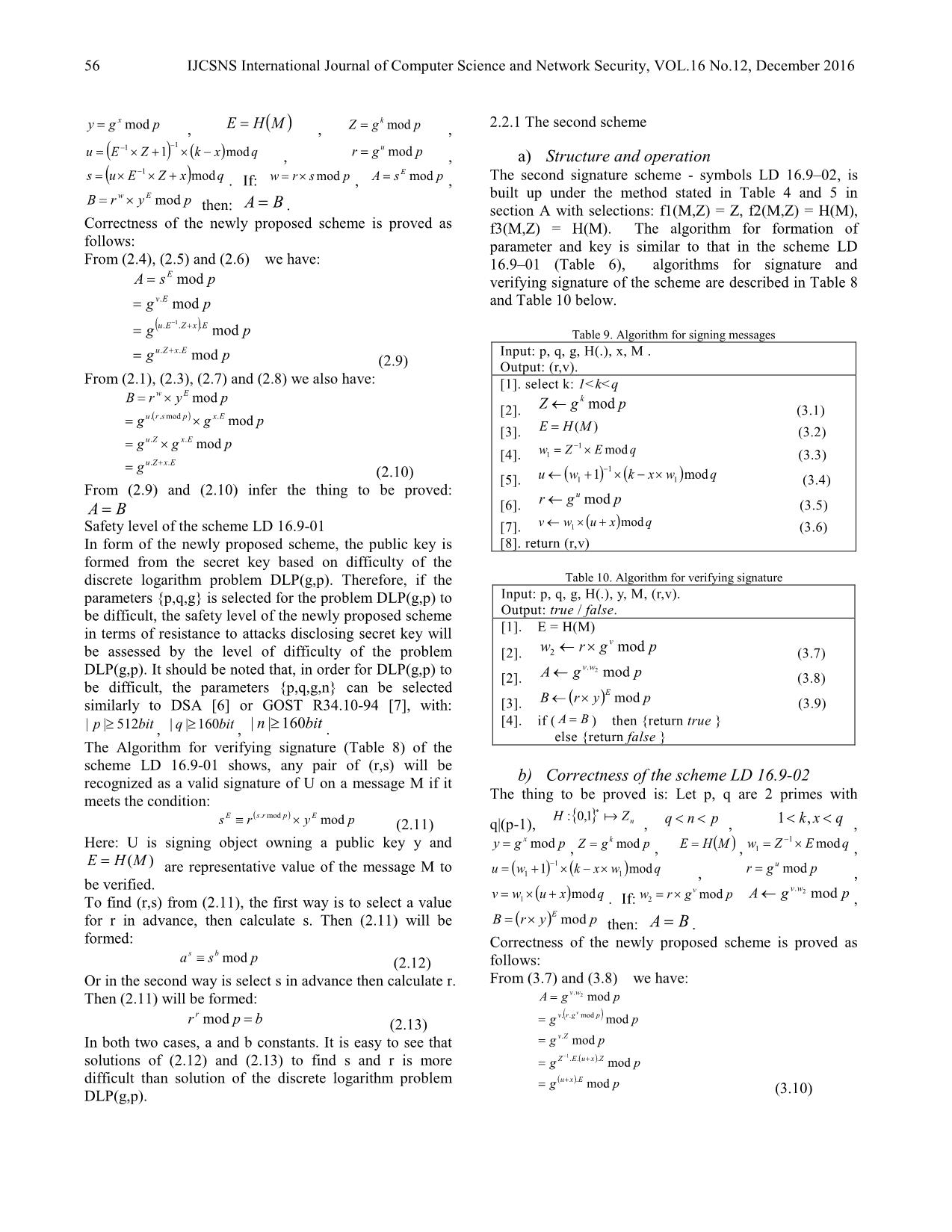
Trang 4
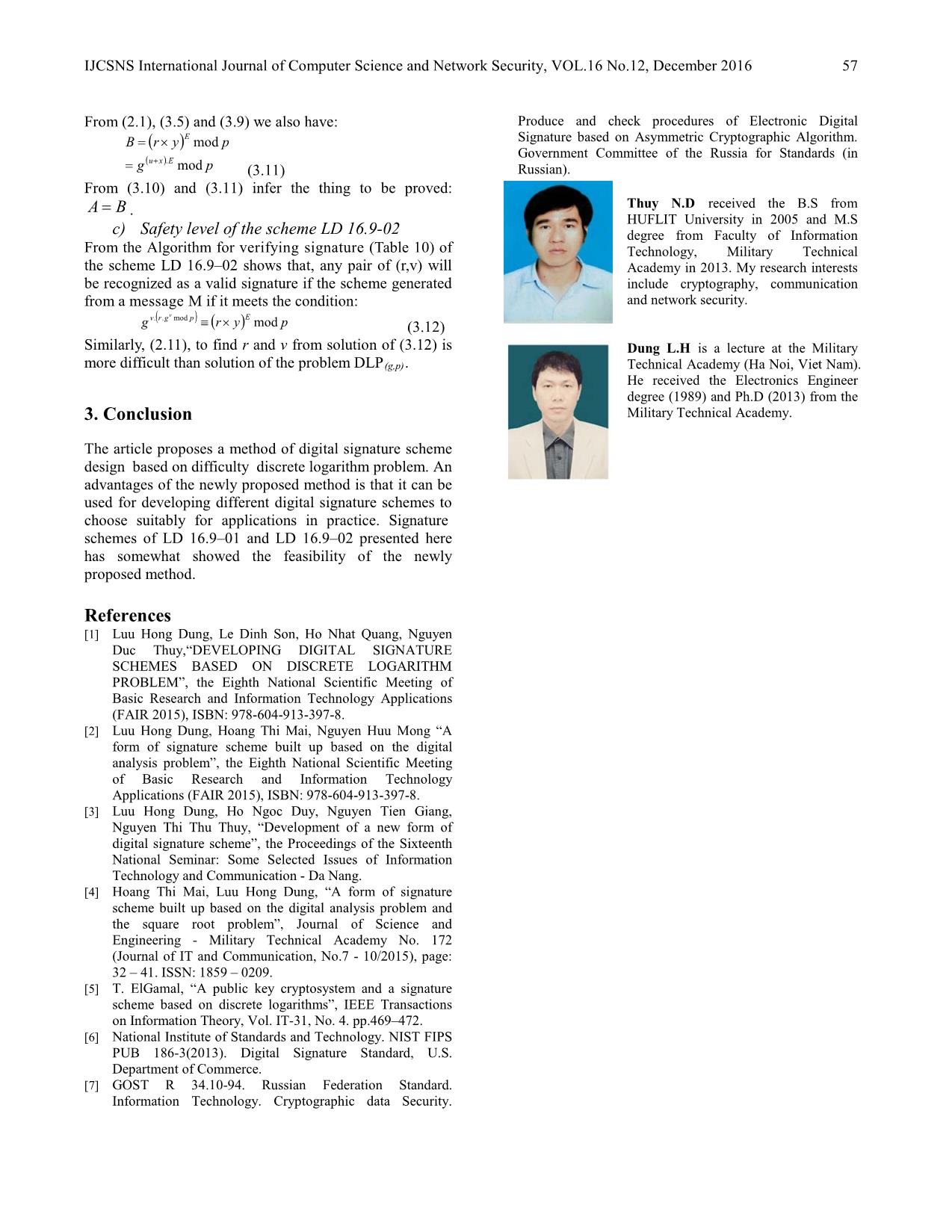
Trang 5
Tóm tắt nội dung tài liệu: A new construction method of digital signature algorithms
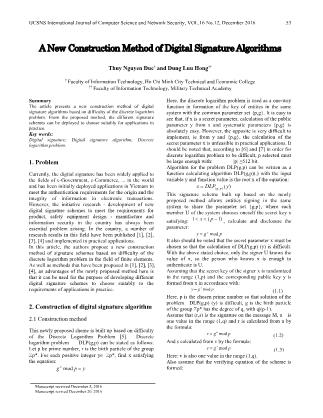
IJCSNS International Journal of Computer Science and Network Security, VOL.16 No.12, December 2016
53
Manuscript received December 5, 2016
Manuscript revised December 20, 2016
A New Construction Method of Digital Signature Algorithms
Thuy Nguyen Đuc† and Dung Luu Hong††
† Faculty of Information Technology, Ho Chi Minh City Technical and Economic College
†† Faculty of Information Technology, Military Technical Academy
Summary
The article presents a new construction method of digital
signature algorithms based on difficulty of the discrete logarithm
problem. From the proposed method, the different signature
schemes can be deployed to choose suitably for applications in
practice.
Key words:
Digital signature; Digital signature algorithm; Discrete
logarithm problem.
1. Problem
Currently, the digital signature has been widely applied to
the fields of e-Government, e-Commerce, ... in the world
and has been initially deployed applications in Vietnam to
meet the authentication requirements for the origin and the
integrity of information in electronic transactions.
However, the initiative research - development of new
digital signature schemes to meet the requirements for
product, safety equipment design - manufacture and
information security in the country has always been
essential problem arising. In the country, a number of
research results in this field have been published [1], [2],
[3], [4] and implemented in practical applications.
In this article, the authors propose a new construction
method of signature schemes based on difficulty of the
discrete logarithm problem in the field of finite elements.
As well as methods that have been proposed in [1], [2], [3],
[4], an advantages of the newly proposed method here is
that it can be used for the purpose of developing different
digital signature schemes to choose suitably to the
requirements of applications in practice.
2. Construction of digital signature algorithm
2.1 Construction method
This newly proposed sheme is built up based on difficulty
of the Discrete Logarithm Problem [5]. Discrete
logarithm problem – DLP(g,p) can be stated as follows:
Let p be prime number, r is the birth particle of the group
ℤp*. For each positive integer y∈ ℤp*, find x satisfying
the equation:
ypg
x =mod
Here, the discrete logarithm problem is used as a one-way
function in formation of the key of entities in the same
system with the common parameter set {p,g}. It is easy to
see that, if x is a secret parameter, calculation of the public
parameter y from x and systematic parameters {p,g} is
absolutely easy. However, the opposite is very difficult to
implement, ie from y and {p,g}, the calculation of the
secret parameter x is unfeasible in practical applications. It
should be noted that, according to [6] and [7] in order for
discrete logarithm problem to be difficult, p selected must
be large enough with: |p| ≥512 bit.
Algorithm for the problem DLP(g,p) can be written as a
function calculating algorithm DLP(g,p)(.) with the input
variable y and function value is the root x of the equation:
)(),( yDLPx pg=
This signature scheme built up based on the newly
proposed method allows entities signing in the same
system to share the parameter set {g,p}, where each
member U of the system chooses oneself the secret key x
satisfying: )1(1 −<< px , calculate and disclosure the
parameter:
pgy
x mod=
It also should be noted that the secret parameter x must be
chosen so that the calculation of DLP(g,p) (y) is difficult.
With the above stated choice, only the signer U knows the
value of x, so the person who knows x is enough to
authenticate is U.
Assuming that the secret key of the signer x is randomized
in the range (1,p) and the corresponding public key y is
formed from x in accordance with:
pgy
x mod= (1.1)
Here, p is the chosen prime number so that solution of the
problem DLP(g,p) (y) is difficult, g is the birth particle
of the group ℤp* has the degree of q, with q|(p-1).
Assume that (r,s) is the signature on the message M, u is
one value in the range (1,q) and r is calculated from u by
the formula:
pgr
u mod= (1.2)
And s calculated from v by the formula:
pgs
v mod= (1.3)
Here: v is also one value in the range (1,q).
Also assume that the verifying equation of the scheme is
formed:
IJCSNS International Journal of Computer Science and Network Security, VOL.16 No.12, December 2016
54
( )( ) ( )( ) ( )( ) pyrs srfMfsrfMfsrfMf mod,,,,,, 321 ×≡
With ),( srf is the function of r and s. Consider the case:
pg
psrsrf
k mod
mod),(
=
×=
(1.4)
Where k is a randomly chosen value in the range (1,q).
Set:
Zpg
k =mod (1.5)
Then, the verifying equation can be taken to the form:
( ) ( ) ( ) pyrs ZMfZMfZMf mod,,, 321 ×≡ (1.6)
From (1.1), (1.2), (1.3) and (1.6) we have:
( ) ( ) ( ) pggg ZMfxZMfuZMfv mod,.,.,. 321 ×≡ (1.7)
From (1.7) infer:
qZMfx
ZMfuZMfv
mod)],(
),([),(
3
21
×+
+×≡×
(1.8)
So:
qZMfZMfx
ZMfZMfuv
mod),(),(
),(),((
3
1
1
2
1
1
××+
××=
−
−
(1.9)
On the other hand, from (1.2), (1.3) and (1.4) we have:
( ) kquv =+ mod (1.10)
From (1.9) and (1.10) we have:
k
quZMfZMfx
ZMfZMfu
=
+××+
+××
−
−
mod]),(),(
),(),([
3
1
1
2
1
1
Or:
k
qZMfZMfx
ZMfZMfu
=
××+
+××
−
−
mod)],(),(
)1),(),(([
3
1
1
2
1
1
(1.11)
From (1.11), infer:
qZMfZMfxk
ZMfZMfu
mod)],(),((
)1),(),([(
3
1
1
1
2
1
1
××−
×+×=
−
−−
(1.12)
From (1.12), the first component of signature is calculated
by (1.2):
pgr
u mod=
and the second component is calculated by (1.3):
pgs
v mod=
with v calculated by (1.9):
qZMfZMfx
ZMfZMfuv
mod)],(),(
),(),([
3
1
1
2
1
1
××+
+××=
−
−
From here, a form of signature scheme corresponding to
the case: pgpsrsrf
k modmod),( =×= is shown as
Table 1, Table 2 and Table 3 below.
Table 1. Algorithm for formation parameter and key
Input: p, q, x.
Output: g, y.
[1]. select h: 1<h<p
[2].
( ) phg qp mod/1−←
[3]. if ( g = 1) then go to [1]
[4]. pgy
x mod←
[5]. return {g,y}
Remarks:
(i) p,q: primes satisfying conditions:
1+×= qNp , N=1,2,3,.
(ii) x,y: secret, public keys of signing object U.
Table 2. Algorithm for formation of signature
Input: p, q, g, x, M.
Output: (r,s).
[1]. select k: 1<k<q
[2]. pgZ
k mod←
[3]. ),(11 ZMfw ←
[4]. ),(22 ZMfw ←
[5]. ),(33 ZMfw ←
[6]. ( ) qwww mod2
1
14 ×←
−
[7]. ( ) qwww mod3
1
15 ×←
−
[8]. ( ) ( ) qwxkwu mod1 5
1
4 ×−×+←
−
[9]. pgr
u mod←
[10]. ( ) qwxwuv mod54 ×+×←
[11]. pgs
v mod←
[12]. return (r,s)
Remarks:
(i) M: the message to be signed, with:
∞∈ }1,0{M .
(ii) (r,s): signature of U on M.
Table 3. Algorithm for verifying signature
Input: p, q, g, y, {M,(r,s)}.
Output: true / false.
[1]. ),( srfZ ←
[2]. ),(11 ZMfw ←
[3]. ),(22 ZMfw ←
[4]. ),(33 ZMfw ←
[5]. psA
w mod1←
[6]. pyrB
ww mod32 ×←
[7]. if (A=B) then {return true}
else {return false}
Remarks:
(i) M, (r,s): the messages, signature need verifying.
IJCSNS International Journal of Computer Science and Network Security, VOL.16 No.12, December 2016
55
(ii) If the return is true, the integrity and origin of M are
confirmed. Conversely, if the return is false, M is denied
the origin and integrity.
It should be noted that the signature created here is not
necessarily the pair of (r,s). From the Table 2 shows that
the value v can be selected as the second component of the
signature instead of s, thus reduce one calculation step in
the procedure for formation of signature. Indeed, if the
hypothesis of the verifying equation of the scheme is
formed:
( )( ) ( )( ) ( )( ) pyrg vrfMfvrfMfvrfMfv mod,,,,,,. 321 ×≡ (1.13)
and:
pgpgrvrf kv modmod),( =×= (1.14)
Set:
Zpg
k =mod
Then, from (1.1), (1.2) and (1.13) we also have:
( )( ) ( )( ) ( )( ) pggg vrfMfxvrfMfuvrfMfv mod,,.,,.,,. 321 ×≡
From here, algorithms for formation and verifying
signature of the form of the scheme corresponding to new
assumptions given in Table 4 and Table 5 as follows:
Table 4. Algorithm for formation of signature
Input: p, q, g, x, M.
Output: (r,v).
[1]. select k: 1<k<q
[2]. pgZ
k mod←
[3]. ),(11 ZMfw ←
[4]. ),(22 ZMfw ←
[5]. ),(33 ZMfw ←
[6]. ( ) qwww mod2
1
14 ×←
−
[7]. ( ) qwww mod3
1
15 ×←
−
[8]. ( ) ( ) qwxkwu mod1 5
1
4 ×−×+←
−
[9]. pgr
u mod←
[10]. ( ) qwxwuv mod54 ×+×←
[11]. return (r,v)
Table 5. Algorithm for verifying signature
Input: p, q, g, y, {M,(r,v)}.
Output: true / false.
[1]. ),( vrfZ ←
[2]. ),(11 ZMfw ←
[3]. ),(22 ZMfw ←
[4]. ),(33 ZMfw ←
[5]. pgA
wv mod1.←
[6]. pyrB
ww mod32 ×←
[7]. if ( BA = ) then {return true }
else {return false }
2.2 Several algorithms for signature built up under
the proposed method
2.2.1 The first scheme
a) Structure and operation
The first signature scheme proposed here - symbols LD
16.9–01, is built up under Table 1, 2 and 3 in section A
with selections: )(),(1 MHZMf = , ZZMf =),(2 ,
)(),(3 MHZMf = . Algorithms for formation of parameter
and key, algorithm for signature and verifying signature of
the scheme are described in the Table 6, Table 7 and Table
8 below.
Table 6. Algorithm for formation of parameter and key
Input: p, q, x.
Output: g, y, H(.).
[1]. select h: 1<h<p
[2].
( ) phg qp mod/1−←
[3]. if ( g = 1) then goto [1]
[4] pgy
x mod← . (2.1)
[5]. select
{ } nZH ∗1,0: , pnq <<
[6]. return {g,y,H(.)}
Remarks:
- H(.): Hash function (SHA, MD5, ...).
Table 7. Algorithm for signing messages
Input: p, q, g, H(.), x, M .
Output: (r,s).
[1]. )(MHE =
[2]. select k: 1<k<q
[3] pgZ
k mod← (2.2)
[4]. ( ) ( ) qxkZEu mod1
11 −×+×←
−−
[5]. pgr
u mod← (2.3)
[6]. ( ) qxZEuv mod1 +××← − (2.4)
[7]. pgs
v mod← (2.5)
[8]. return (r,s)
Table 8. Algorithm for verifying signature
Input: p, q, g, H(.), y, M, (r,s).
Output: true / false.
[1]. )(MHE =
[2]. psA
E mod← (2.6)
[3]. psrw mod×← (2.7)
[4]. pyrB
Ew mod×← (2.8)
[5]. if ( BA = ) then {return true }
else {return false }
b) Correctness of the scheme LD 16.9-01
The thing to be proved is: Let p, q are 2 primes with
q|(p-1), { } nZH
∗1,0: , pnq << , qxk << ,1 ,
IJCSNS International Journal of Computer Science and Network Security, VOL.16 No.12, December 2016
56
pgy x mod= , ( )MHE = , pgZ k mod= ,
( ) ( ) qxkZEu mod1 11 −×+×= −− , pgr u mod= ,
( ) qxZEus mod1 +××= − . If: psrw mod×= , psA E mod= ,
pyrB Ew mod×= then: BA = .
Correctness of the newly proposed scheme is proved as
follows:
From (2.4), (2.5) and (2.6) we have:
( )
pg
pg
pg
psA
ExZu
ExZEu
Ev
E
mod
mod
mod
mod
..
...
.
1
+
+
=
=
=
=
−
(2.9)
From (2.1), (2.3), (2.7) and (2.8) we also have:
( )
ExZu
ExZu
Expsru
Ew
g
pgg
pgg
pyrB
..
..
.mod..
mod
mod
mod
+=
×=
×=
×=
(2.10)
From (2.9) and (2.10) infer the thing to be proved:
BA =
Safety level of the scheme LD 16.9-01
In form of the newly proposed scheme, the public key is
formed from the secret key based on difficulty of the
discrete logarithm problem DLP(g,p). Therefore, if the
parameters {p,q,g} is selected for the problem DLP(g,p) to
be difficult, the safety level of the newly proposed scheme
in terms of resistance to attacks disclosing secret key will
be assessed by the level of difficulty of the problem
DLP(g,p). It should be noted that, in order for DLP(g,p) to
be difficult, the parameters {p,q,g,n} can be selected
similarly to DSA [6] or GOST R34.10-94 [7], with:
bitp 512|| ≥ , bitq 160|| ≥ , bitn 160|| ≥ .
The Algorithm for verifying signature (Table 8) of the
scheme LD 16.9-01 shows, any pair of (r,s) will be
recognized as a valid signature of U on a message M if it
meets the condition:
( ) pyrs EprsE modmod. ×≡ (2.11)
Here: U is signing object owning a public key y and
)(MHE = are representative value of the message M to
be verified.
To find (r,s) from (2.11), the first way is to select a value
for r in advance, then calculate s. Then (2.11) will be
formed:
psa
bs mod≡ (2.12)
Or in the second way is select s in advance then calculate r.
Then (2.11) will be formed:
bpr
r =mod (2.13)
In both two cases, a and b constants. It is easy to see that
solutions of (2.12) and (2.13) to find s and r is more
difficult than solution of the discrete logarithm problem
DLP(g,p).
2.2.1 The second scheme
a) Structure and operation
The second signature scheme - symbols LD 16.9–02, is
built up under the method stated in Table 4 and 5 in
section A with selections: f1(M,Z) = Z, f2(M,Z) = H(M),
f3(M,Z) = H(M). The algorithm for formation of
parameter and key is similar to that in the scheme LD
16.9–01 (Table 6), algorithms for signature and
verifying signature of the scheme are described in Table 8
and Table 10 below.
Table 9. Algorithm for signing messages
Input: p, q, g, H(.), x, M .
Output: (r,v).
[1]. select k: 1<k<q
[2]. pgZ
k mod← (3.1)
[3]. )(MHE = (3.2)
[4]. qEZw mod
1
1 ×=
−
(3.3)
[5]. ( ) ( ) qwxkwu mod1 1
1
1 ×−×+←
−
(3.4)
[6]. pgr
u mod← (3.5)
[7]. ( ) qxuwv mod1 +×← (3.6)
[8]. return (r,v)
Table 10. Algorithm for verifying signature
Input: p, q, g, H(.), y, M, (r,v).
Output: true / false.
[1]. E = H(M)
[2]. pgrw
v mod2 ×← (3.7)
[2]. pgA
wv mod2.← (3.8)
[3]. ( ) pyrB
E mod×← (3.9)
[4]. if ( BA = ) then {return true }
else {return false }
b) Correctness of the scheme LD 16.9-02
The thing to be proved is: Let p, q are 2 primes with
q|(p-1), { } nZH
∗1,0: , pnq << , qxk << ,1 ,
pgy x mod= , pgZ
k mod= , ( )MHE = , qEZw mod
1
1 ×=
−
,
( ) ( ) qwxkwu mod1 111 ×−×+= − , pgr
u mod= ,
( ) qxuwv mod1 +×= . If: pgrw
v mod2 ×= pgA
wv mod2.← ,
( ) pyrB E mod×= then: BA = .
Correctness of the newly proposed scheme is proved as
follows:
From (3.7) and (3.8) we have:
( )
( )
( ) pg
pg
pg
pg
pgA
Exu
ZxuEZ
Zv
pgrv
wv
v
mod
mod
mod
mod
mod
.
...
.
mod..
.
1
2
+
+
=
=
=
=
=
−
(3.10)
IJCSNS International Journal of Computer Science and Network Security, VOL.16 No.12, December 2016
57
From (2.1), (3.5) and (3.9) we also have:
( )
( ) pg
pyrB
Exu
E
mod
mod
.+=
×=
(3.11)
From (3.10) and (3.11) infer the thing to be proved:
BA = .
c) Safety level of the scheme LD 16.9-02
From the Algorithm for verifying signature (Table 10) of
the scheme LD 16.9–02 shows that, any pair of (r,v) will
be recognized as a valid signature if the scheme generated
from a message M if it meets the condition:
( ) ( ) pyrg Epgrv v modmod.. ×≡ (3.12)
Similarly, (2.11), to find r and v from solution of (3.12) is
more difficult than solution of the problem DLP (g,p).
3. Conclusion
The article proposes a method of digital signature scheme
design based on difficulty discrete logarithm problem. An
advantages of the newly proposed method is that it can be
used for developing different digital signature schemes to
choose suitably for applications in practice. Signature
schemes of LD 16.9–01 and LD 16.9–02 presented here
has somewhat showed the feasibility of the newly
proposed method.
References
[1] Luu Hong Dung, Le Dinh Son, Ho Nhat Quang, Nguyen
Duc Thuy,“DEVELOPING DIGITAL SIGNATURE
SCHEMES BASED ON DISCRETE LOGARITHM
PROBLEM”, the Eighth National Scientific Meeting of
Basic Research and Information Technology Applications
(FAIR 2015), ISBN: 978-604-913-397-8.
[2] Luu Hong Dung, Hoang Thi Mai, Nguyen Huu Mong “A
form of signature scheme built up based on the digital
analysis problem”, the Eighth National Scientific Meeting
of Basic Research and Information Technology
Applications (FAIR 2015), ISBN: 978-604-913-397-8.
[3] Luu Hong Dung, Ho Ngoc Duy, Nguyen Tien Giang,
Nguyen Thi Thu Thuy, “Development of a new form of
digital signature scheme”, the Proceedings of the Sixteenth
National Seminar: Some Selected Issues of Information
Technology and Communication - Da Nang.
[4] Hoang Thi Mai, Luu Hong Dung, “A form of signature
scheme built up based on the digital analysis problem and
the square root problem”, Journal of Science and
Engineering - Military Technical Academy No. 172
(Journal of IT and Communication, No.7 - 10/2015), page:
32 – 41. ISSN: 1859 – 0209.
[5] T. ElGamal, “A public key cryptosystem and a signature
scheme based on discrete logarithms”, IEEE Transactions
on Information Theory, Vol. IT-31, No. 4. pp.469–472.
[6] National Institute of Standards and Technology. NIST FIPS
PUB 186-3(2013). Digital Signature Standard, U.S.
Department of Commerce.
[7] GOST R 34.10-94. Russian Federation Standard.
Information Technology. Cryptographic data Security.
Produce and check procedures of Electronic Digital
Signature based on Asymmetric Cryptographic Algorithm.
Government Committee of the Russia for Standards (in
Russian).
Thuy N.D received the B.S from
HUFLIT University in 2005 and M.S
degree from Faculty of Information
Technology, Military Technical
Academy in 2013. My research interests
include cryptography, communication
and network security.
Dung L.H is a lecture at the Military
Technical Academy (Ha Noi, Viet Nam).
He received the Electronics Engineer
degree (1989) and Ph.D (2013) from the
Military Technical Academy.
File đính kèm:
 a_new_construction_method_of_digital_signature_algorithms.pdf
a_new_construction_method_of_digital_signature_algorithms.pdf

